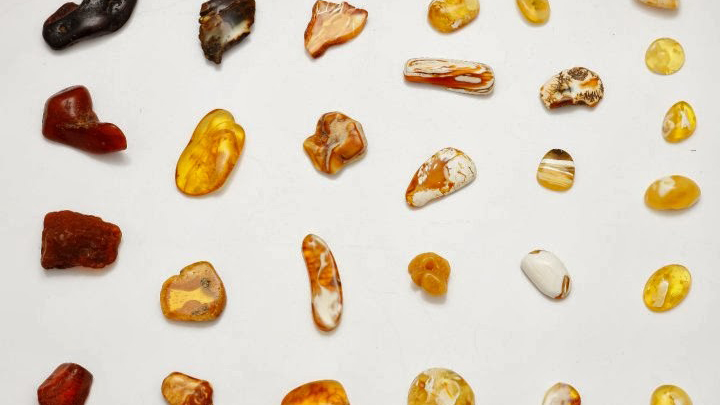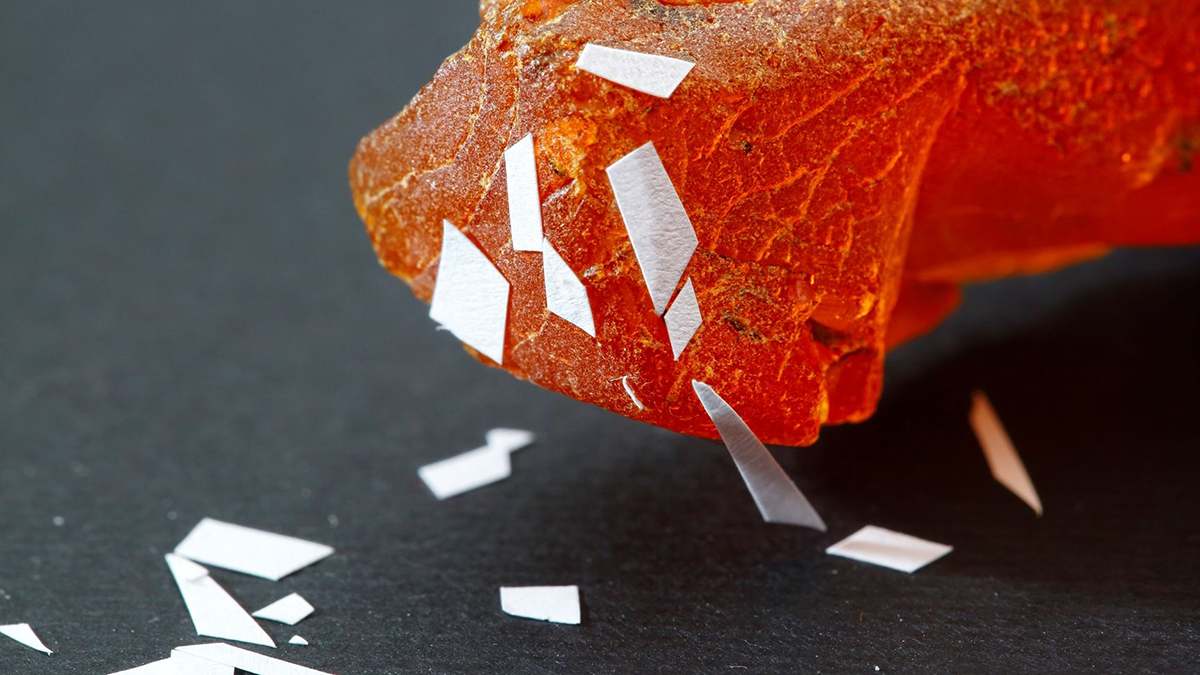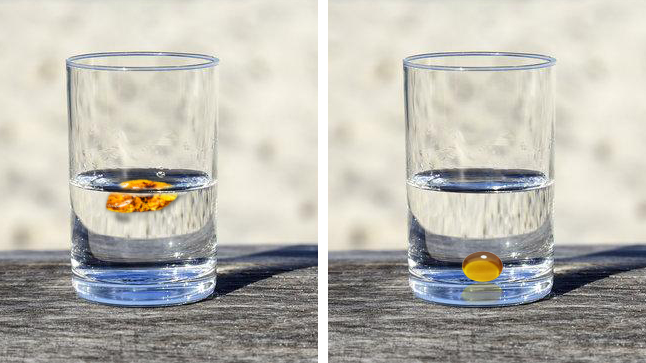 Blog
Blog  Immersing in the Radiance of Amber: A Journey through Amber's Multitude of Colors and their Cultural Resonance
Immersing in the Radiance of Amber: A Journey through Amber's Multitude of Colors and their Cultural Resonance
Immersing in the Radiance of Amber: A Journey through Amber's Multitude of Colors and their Cultural Resonance
- Unveiling the Intricacies of Amber
- Decoding Amber's Color Influencers
- Venturing into Amber's Color Realm
- Symbolism of Amber's Colors and Its Cultural Importance
- Amber’s Healing Properties
- Amber Imitations and How to Identify Genuine Amber
- The Wondrous World of Amber
Amber, a gemstone of profound allure and rarity, has been held in the highest esteem for its captivating beauty over millennia. Its color palette, a breathtaking spectrum from sunny yellow and fiery orange to earthy brown and deep red, is a manifestation of the factors influencing its chemical makeup and physical properties. In this enlightening discourse, we'll delve into the intriguing science behind amber's diverse hues, their cultural relevance, and tips to distinguish genuine amber from its counterfeit counterparts. Moreover, to make this exploration more engaging, we'll pepper the narrative with some intriguing tidbits.

Unveiling the Intricacies of Amber
Amber owes its existence to the fossilized resin of prehistoric trees, predominantly pines. This resin, a tree's natural defense against pests and disease, undergoes a transformation over millennia. Through a process known as polymerization, cross-linking of organic molecules occurs, giving birth to the sturdy, amber material we're familiar with today.
The hue of amber can be influenced by numerous elements, such as the resin's original color, the oxidation level, and the presence of impurities. Commonly, amber graces us with shades of yellow, orange, brown, and red. Fresh, unblemished resin, which has encountered minimal oxidation, yields yellow and orange amber. Conversely, brown and red amber typically stem from resin that has experienced extensive oxidation due to prolonged exposure to sunlight and air.
Impurities also play a crucial role in determining amber's color. For instance, iron oxide lends a reddish-brown tint to amber, while manganese imparts a greenish hue. Other color influencers include the depth of burial, temperature and pressure during fossilization, and the duration of time spent underground.
Decoding Amber's Color Influencers
Amber's color spectrum is shaped by three primary factors. Firstly, bubble inclusions within the resin scatter light, leading to color variations. Secondly, the originating tree species matter as certain hues are exclusive to specific trees. It's interesting to note that amber's color can be artificially altered through dyeing or heating processes. Lastly, the age of amber plays a pivotal role in its coloration.
When resin initially seeps from a tree, it's usually clear or pale yellow. The resin can undergo polymerization process, which then results in the darkening and change of it color. The rate of polymerization and thus color of amber depend on several factors, including the type of tree resin and the environmental conditions. All in all, the longer the resin has been buried or subjected to heat and pressure, the more likely it is to have darkened significantly through extensive polymerization. Consequently, older amber stones may bear darker hues than their younger counterparts. For instance, the oldest amber samples, believed to be around 320 million years old, are typically black or dark brown.
Venturing into Amber's Color Realm
Amber, a gemstone of unique beauty and mysterious origins, has been adored for centuries.

- One of the most sought-after amber varieties is White amber or 'bone amber.' Unlike other amber types, which originate from ancient tree resin, white amber is thought to be formed from the bones of long-extinct animals. According to some experts, white amber is a result of polymerization of the fossilized bones of prehistoric birds or mammals. Regardless of its origins, white amber's milky white color, rarity, and distinctive beauty make it highly coveted.
- Yellow and honey amber. The most frequently encountered amber colors are yellow and honey, their warm and sunny hues varying from almost translucent pale to deep, rich golden tones. These amber types, predominantly discovered in Europe's Baltic region, are cherished for their inviting glow.
- Cognac amber. Cognac amber, an enchanting brownish-orange amber variant, has a tone slightly darker than yellow or honey amber. This hue finds favor among buyers as it harmonizes well with silver and other jewelry materials, giving birth to a plethora of shades from light to dark.
- Green amber. Green amber, a striking amber type, comes into existence when tree resin mixes with nearby plants, allowing the chlorophyll pigment in these plants to react with the resin, creating a distinctive green color. Occasionally, plant parts get trapped inside the resin, further influencing the color. Green amber, varying from light to dark shades, is often associated with good fortune and even immortality.
- Blue amber. Blue amber, known for its unique blue-green hue, is a rare and highly prized form of amber. Primarily found in the Dominican Republic's mountains, it ranks among the rarest and most valuable amber types globally.
- Red amber. Red amber or cherry amber, one of the rarest amber colors, accounts for a mere 0.5% of all amber resources. Prolonged exposure to air results in an orange to deep red color spectrum. Due to its rarity and purported mystical powers, red amber has been highly valued in Japan, and it was featured in Shosoin treasures as "dragon's blood."
- Black amber. Black amber, accounting for about 15% of all amber found today, is a unique and intriguing amber variant. Often, black amber's color results from impurities trapped within, such as remnants of trees or other plants. These impurities can sometimes constitute up to 90% of the amber piece, making it more challenging to prepare stones for jewelry making. Fascinatingly, black amber can reveal other colors when held up to the light, such as red, brown, and other shades. Over the years, black amber has been linked with mystical powers, including protection from evil spirits and enemies.
- Copal. Copal is not amber gemstone but it is often referred to as "young amber." Copal is a type of resin that hasn't undergone the full process of polymerization. Discovered in various parts of the world, including Central and South America, Africa, and Asia, copal is only a few hundred years old unlike amber, which thousands and millions of years old. While copal may resemble amber, it's generally softer, less dense, and has a lower melting point, meaning it can be melted and reshaped more easily.
Symbolism of Amber's Colors and Its Cultural Importance
The warm, golden hues of amber have been a source of fascination and inspiration for people all over the world from ancient times to the modern era. Its significance in cultural and religious traditions has remained steadfast.
In ancient Greece, amber was perceived as the tears of the gods, a potent and mystical substance. Romans esteemed amber as a symbol of wealth and power, with its warm, honey tones representing the sun, a life-giving force in many cultures.
Amber's cultural importance transcends its color, with various hues symbolizing different attributes and emotions. For instance, yellow and honey amber, associated with the life-giving sun, were thought to bring good luck and happiness. Red amber, with its deep, rich hues, was believed to invoke passion and love. Green amber, with its calming tones, was said to foster balance and harmony, offering a sense of tranquility and peace.
Amber’s Healing Properties
Amber's cultural and symbolic significance is accompanied by its long-prized healing properties. Ancient civilizations believed it could cure ailments such as headaches, respiratory issues, and joint pain. Today, many individuals still use amber as a healing stone in alternative medicine, citing its calming effect on the body and its potential to alleviate stress and anxiety, making it a favored choice for those seeking natural and holistic healing methods.
Amber Imitations and How to Identify Genuine Amber
While the allure of amber has enchanted people for centuries, imitations have emerged, making it crucial for potential buyers to distinguish between genuine amber and counterfeit versions. In order to ensure you're purchasing authentic amber, consider the following tips:
- Visual Inspection: Observe the piece closely. Genuine amber often contains natural inclusions, such as tiny air bubbles, plant fragments, or even ancient insects. Imitations, on the other hand, usually appear flawless and overly polished.
- Touch Test: Authentic amber is warm to the touch and lightweight, while imitations, often made of glass or plastic, feel colder and heavier.
- Static Electricity Test: Rub the amber piece with a soft cloth or against your hair to generate static electricity. Genuine amber will attract small, lightweight items like paper, while imitations will not.

- Saltwater Test: Create a mixture of one part salt to two parts water and gently place the amber piece into the solution. Authentic amber will float, while imitations will sink.

- Hot Needle Test: This test should be conducted cautiously and as a last resort. Heat a needle and gently touch it to an inconspicuous area of the amber piece. Genuine amber will give off a pleasant, resinous scent, while imitations will produce an acrid, plastic smell.
The Wondrous World of Amber
Amber, with its captivating allure, has held mankind in its thrall for millennia. The kaleidoscope of hues it displays, from sunny yellows and fiery oranges to earthy browns and rich reds, bear witness to the countless elements that influence its chemical makeup and tangible characteristics. The cultural meanings and symbolism intertwined with each shade of amber serve to enhance its charm, as do the reputed curative properties ascribed to this extraordinary jewel.
As you journey further into the enchanting realm of amber, you'll unearth the intriguing science that underpins its genesis and the remarkable odyssey it has embarked upon through the ages. Whether you're a dedicated connoisseur, a jewelry enthusiast, or simply an admirer of the splendors crafted by nature, amber extends a treasure trove of fascination and mystery for everyone to delve into.
The impact of amber colors throughout history has been both far-reaching and long-lasting. From its mystical properties in ancient Greece to its contemporary use as a healing stone, amber continues to captivate and inspire people with its warm, golden hues and potent symbolism. When searching for amber jewelry, look no further than Amberhats.com, where you'll discover a stunning array of high-quality, authentic amber pieces guaranteed to take your breath away.

The Amberhats Team is a collective of passionate writers dedicated to sharing insights, tips, and the latest trends in the world of hats. With a diverse background in fashion, craftsmanship, and style, our team strives to provide valuable and engaging content for hat enthusiasts and casual readers alike. Whether you're looking for styling advice, care tips, or the history behind iconic hat designs, the Amberhats Team is here to enrich your knowledge and enhance your love for headwear.
Recent posts
Amber in Skincare: Benefits and Uses in Beauty Products
Amber has long been prized not only for its stunning beauty as a gemstone but also for its therapeutic and cosmetic properties. With a history steeped in ...
by Amberhats Team Nov 01, 2024 3510
Sailing into the Mystic Seas of Amber: Discovering Its Healing Qualities, Uses, and Hidden Benefits
From the Dawn of Time Amber: An Elixir of Restoration Amber in Holistic Healing Amber in Jewelry and Fashion How to Benefit from Amber Stones? How ...
by Amberhats Team Jun 26, 2023 3313
Rediscovering Amber: The Best Christmas Present 2023
As the frost of winter sets in and festive bells chime, the annual hunt for that impeccable Christmas gift begins. Diamonds have traditionally stolen the ...
by Amberhats Team Dec 14, 2023 1431



Спасибо за Ваш голос